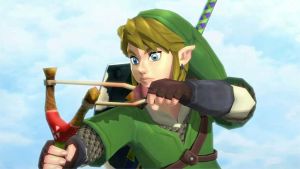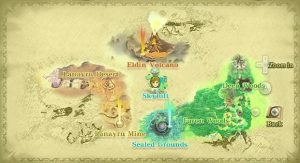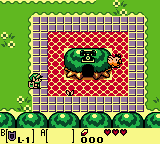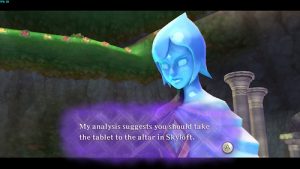The crucial things Skyward Sword got wrong

Despite releasing to critical acclaim, The Legend of Zelda: Skyward Sword got a lot of things wrong.
A lot of the good things from previous entries in the series were either watered down or completely abandoned. I enjoyed Skyward Sword, but not to the extent I enjoyed most of the other entries in the series, and I wouldn’t call it a great game.
The game’s flaws mark a concerning trend of declining quality in the franchise, many of which were also present in Twilight Princess, and started to show in Wind Waker. Other adventure/action RPGs have since eclipsed Zelda in the genre it used to define and dominate; the likes of Dark Souls and The Witcher have built upon the foundation laid by Zeldas of old, much more successfully than recent Zelda games.
Here are the crucial things Skyward Sword gets wrong, which I hope can get set right in future incarnations of the franchise.
1. A Segmented World
One of the things older Zeldas succeed at is creating the sense of a living, breathing and above-all inter-connected world for the player. In a good Zelda game, different areas of the world join others in multiple ways, helping foster the sense that this is one cohesive land that you’re trying to save.
Wind Waker is probably the best example of this – the sea is completely open to you, and sailing from one island to the next – free of loading times – knits the world together in the player’s mind. But it’s not just about eliminating loading times. Traversing between areas in Ocarina of Time required loading, but the game manages to keep the feeling of a connected land in other simple but effective ways. For example, you can see Death Mountain from most of the areas, looming in the distance, and Ganondorf’s castle is dominant on the horizon of most of Hyrule Field. Showing the player glimpses of where they will go or where they have been is a really effective way of connecting the world. Dark Souls uses this effect in abundance..

The segmented overworld map of Skyward Sword.
Skyward Sword, however, fails in this department. Skyloft is above the clouds, which is fine in itself – it’s a large hub, with plenty to do on the main island. The problem lies in the way the game’s other areas are accessed and presented. To travel to each location, you must fly to a beam of light and jump off your loftwing, plunging to the earth below. This is done in the form of a cut scene, and you can select form a number of spots to land. There are a few reasons why this is a bad design decision. Gone is Wind Waker’s seamless transitioning, and because you select from a map before you land, also gone is any sense of tangible connection between Skyloft and the world below. It’s akin to jumping into a painting in Mario 64. This worked in Mario, because as the player we accepted that the painting levels were distinct isolated universes of their own – the game didn’t have a narrative that relied on the areas being connected, whereas Skyward Sword does.
Even without seamless transitioning, Skyward Sword still fails where Ocarina succeeded, because it doesn’t even hint at the world below from up in clouds. You can’t peer down onto Hyrule from up above, which I think is an opportunity missed by the developers. Worse still, the different areas beneath the clouds do not connect in any way – there’s no way to traverse between Eldin, Faron and Lanayru when on the ground, shattering all impression of connectivity. You can’t even see Eldin volcano from the other areas.
2. Handholding

The optional booths in Link’s Awakening struck the perfect balance between guidance and player autonomy.
An area that Zelda games differ in considerably, but has become more prevalent in each iteration, is the guidance it gives the player. The original Legend of Zelda is notorious for the lack of help available, leaving you to your own wits and devices. I don’t think complete lack of guidance is necessarily the ideal solution for a Zelda game, as they should cater for players that require prods in the right direction. But the best Zeldas keep it optional. Link’s Awakening handles it well, largely leaving the player to figure things out on their own but including ‘phone booths’ where the player can go to get a cryptic clue about where to go next. This works because players who would rather figure things out for themselves are free to ignore them, but players needing help can choose to use them.
The 3D Zeldas have tended to make assistance more prominent. Navi and Tatl in Ocarina and Majora respectively are always at hand to help the player, something I feel takes assistance a bit too far. Wind Waker does this a little better, despite being one of the easier Zeldas. The King of Red Lions only occasionally talks to you via your stone, letting you figure things out on your own – but does go slightly too far by insisting on giving you a hint if you run around in a dungeon for too long.
This micro-management-assistance is where the games are starting to let themselves down. Providing help for individual puzzles takes the challenge away, and thus the player’s satisfaction is diminished. Skyward Sword is the worst offender in the Zelda series for doing this, and by some distance. Fi is constantly giving the player obvious and needless information, interrupting gameplay and insulting the player’s intelligence. What is unforgivable from a design perspective is Nintendo don’t give the player the option to turn off the assistance – even in Hero Mode when the game knows you’ve played through once already, Fi is still a constant nag. She’s worse than any of the other helper characters, and her annoyance is only compounded by the fact that she lacks any of the charm possessed by Navi, Tatl and especially Midna.
It’s a real shame that this has become a trend in the series. It’s likely a result of Nintendo wanting to make the games more accessible to a wider audience, but only serves to push established fans away, whilst insulting the intelligence of newer players.
3. Hidden secrets and optional side-quests
Another trend becoming prominent in the series is the lack of optional side-quests, secrets, and choice in general. TLoZ could be tackled in many different ways – you could tackle the dungeons in different orders, and even progress without your sword. This is important because part of what makes the games feel like an adventure is that it feels unique to you, and other people or other play-throughs would experience the same adventure but differently. The more variety on the menu for the player, the more unique their experience feels.

An example of one of the many needless interruptions from Fi.
The player can complete the better Zelda games without experiencing a large amount of the content. In WW, a good proportion of the islands are completely optional, and the came can be finished without charting the whole of the map. Similarly, MM can be finished without collecting all of the masks. What makes these different to simply collecting all of the heart containers is that the rewards on offer in these games are tangible and enhance the game beyond just giving Link more health.
It does make sense that the developers would want the gamers to see what they have spent time creating, especially in modern games where much more time and effort is required to make a secret area, boss or weapon. However if the player feels like every other player is also experiencing what they are, the sense of adventure and discovery is diluted. There is a small part in Twilight Princess that sums this problem up quite well. Towards the end of the game, in Ganon’s castle there is a section featuring a painting of the castle itself, being looked at from a certain point in Hyrule field. When I came across this, I thought the hint was t to go to that point on the map, and look at the castle from this perspective, and a secret event might trigger. Sadly no such secret existed, and all I had to do was fire an arrow at the painting for the reward of a rupee.
It’s disappointing that Zelda’s developers either don’t have the faith in players to add in deep, hidden secrets that the majority of players won’t find. It’s these optional secrets and side-quests that add depth to adventure games, and Zelda is a series that has pioneered the value of such features.
I hope Nintendo isn’t too stubborn or blind to learn from the likes of Dark Souls and recognise where Zelda is going wrong.
The HD version of the last truly great Zelda game, Wind Waker, is available from Amazon here.
don’t forget the literally worst part about the game.
annoying motion controls.
Absolutely agree.
Skyward Sword had some charm to it, but I didn’t find it fun overall. It was mostly fetch quest after fetch quest, and the areas felt like mini-games, not a living breathing world like Ocarina of Time, Wind Waker and Twilight Princess.
To be honest, Miyamoto has ruined many of my favorite franchises with his excessively old-fashioned and arrogant perspective on what makes a good game. He ruined Zelda with Skyward Sword, ruined Paper Mario with Sticker Star, and recently ruined Star Fox with Star Fox Zero. He needs to get off his highhorse and listen to the fans OR even just his younger staff.
I’m happy he is hands off with this new Zelda game. Aonuma has the right mindset and seems to want to make a richer world with more lore and mature themes. Hopefully Zelda U will be the amazing game it seems to shaping up to be.
The very next time I read a blog, Hopefully it doesn’t disappoint me just as much as this one. After all, I know it was my choice to read, but I truly thought you’d have something interesting to say. All I hear is a bunch of crying about something that you could possibly fix if you were not too busy searching for attention.